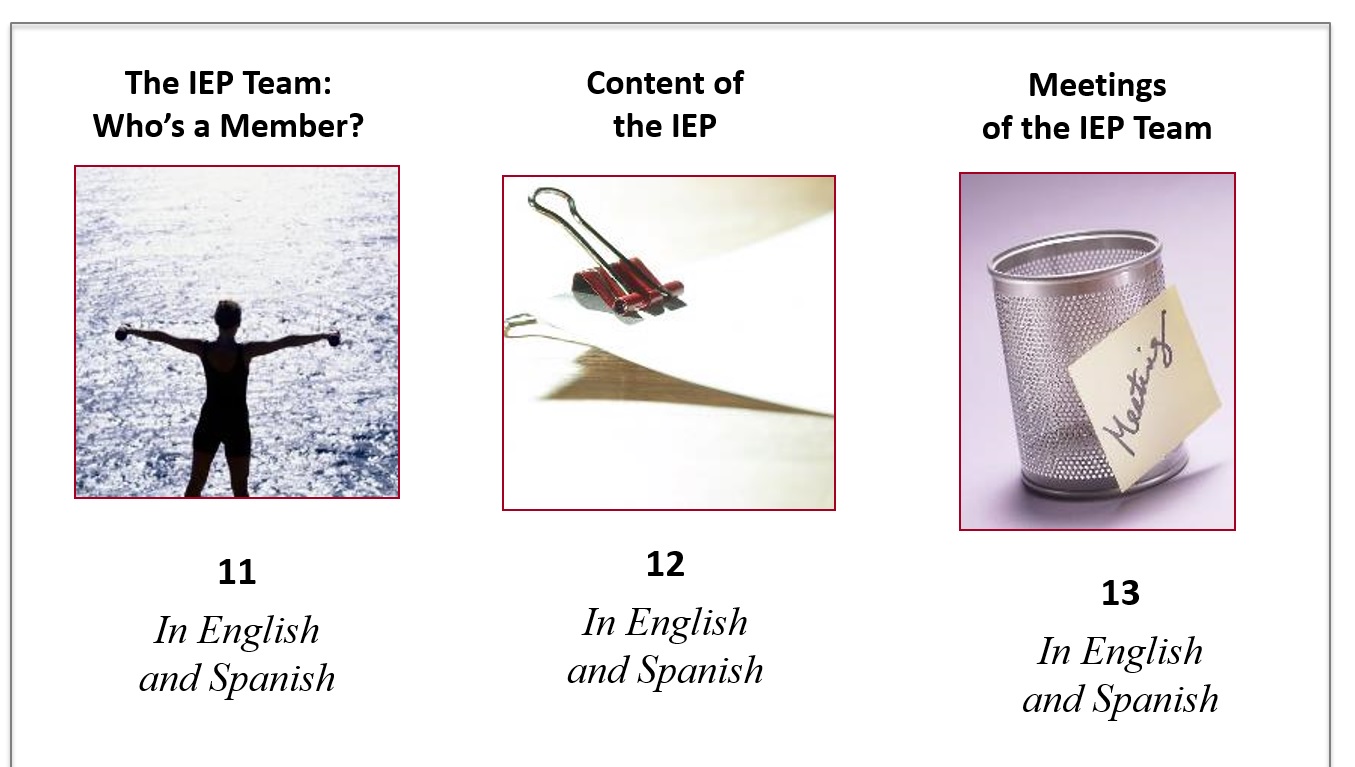Current as of April 2022
In Spanish | En español
An Individualized Education Program (IEP) is a written statement of the educational program designed to meet a child’s individual needs. Every child who receives special education services must have an IEP. That’s why the process of developing this vital document is of great interest and importance to educators, administrators, and families alike. Here’s a crash course on the IEP.
- What’s the IEP’s purpose?
- Who develops the IEP?
- When is the IEP developed?
- What’s in an IEP?
- Can students be involved in developing their own IEPs?
- Resources of more information
What’s the IEP’s purpose?
The IEP has two general purposes:
- to set reasonable learning goals for a child, and
- to state the services that the school district will provide for the child.
Who develops the IEP?
The IEP is developed by a team of individuals that includes key school staff and the child’s parents. The team meets, reviews the assessment information available about the child, and designs an educational program to address the child’s educational needs that result from his or her disability. Want the specifics of who you’ll find on an IEP team? Read the detailed IEP Team page.
When is the IEP developed?
An IEP meeting must be held within 30 calendar days after it is determined, through a full and individual evaluation, that a child has one of the disabilities listed in IDEA and needs special education and related services. A child’s IEP must also be reviewed at least annually thereafter to determine whether the annual goals are being achieved and must be revised as appropriate.
What’s in an IEP?
Each child’s IEP must contain specific information, as listed within IDEA, our nation’s special education law. This includes (but is not limited to):
— the child’s present levels of academic achievement and functional performance, describing how the child is currently doing in school and how the child’s disability affects his or her involvement and progress in the general curriculum
— annual goals for the child, meaning what parents and the school team think he or she can reasonably accomplish in a year
— the special education and related services to be provided to the child, including supplementary aids and services (such as a communication device) and changes to the program or supports for school personnel
— how much of the school day the child will be educated separately from nondisabled children or not participate in extracurricular or other nonacademic activities such as lunch or clubs
— how (and if) the child is to participate in state and district-wide assessments, including what modifications to tests the child needs
— when services and modifications will begin, how often they will be provided, where they will be provided, and how long they will last
— how school personnel will measure the child’s progress toward the annual goals.
For all the details about what the law requires be included in an IEP, dive into our IEP Contents page.
Can students be involved in developing their own IEPs?
Yes, they certainly can be! IDEA actually requires that the student be invited to any IEP meeting where transition services will be discussed. These are services designed to help the student plan for his or her transition to adulthood and life after high school. Lots of information about transition services is available on our Transition to Adulthood page, including how to involve students in their own IEP development.
Resources
Questions, questions? Answers, answers.
A good place to start unravelling the mysteries of the IEP is Wrightslaw.com. The link above will drop you right into the soup, where you’ll find articles, law and regulations, tactics and strategies, tips, books, and free publications about IEPs.
www.wrightslaw.com/info/iep.index.htm
Here’s a roadmap.
Wrightslaw offers us all a “Roadmap to IDEA 2004: What You Need to Know About IEPs & IEP Meetings.”
www.wrightslaw.com/idea/art/iep.roadmap.htm
For parents.
Take a look at Developing Your Child’s IEP and learn how to effectively work with schools to meet the needs of your child.
https://www.parentcenterhub.org/pa12/
For students.
Part of our Transition Suite, this collection of resources speaks directly to students in transition.
https://www.parentcenterhub.org/student-involvement/
Online training in writing an IEP.
This online training is available via California Services for Technical Assistance and Training (CalSTAT) and is specific to benchmarks related to CA content standards. But it’s also conveniently based on IDEA 2004 and deals with writing measurable goals and objectives, a skill quite central to writing effective IEPs.
http://www.cde.ca.gov/sp/se/sr/ieptraining.asp
 Training materials for Parent Centers and others | In English and Spanish.
Training materials for Parent Centers and others | In English and Spanish.
In 2016, CPIR updated the Building the Legacy training modules on the IEP and presented a webinar on the new content. Three training modules are available in English and in Spanish; all are designed for Parent Centers to use in training families and others on the in’s-and-out’s of IEPs. Download them all from:
https://www.parentcenterhub.org/webinar-training-modules-on-iep-idea/
Back to top
________________________________________________________
**Highly Rated Resource! This resource was reviewed by 3-member panels of Parent Center staff working independently from one another to rate the quality, relevance, and usefulness of CPIR resources. This resource was found to be of “High Quality, High Relevance, High Usefulness” to Parent Centers.
________________________________________
Would you like to read more in this suite about the IEP?
Use the jump links below to go to another section of the All about the IEP suite.
- The Short-and-Sweet IEP Overview (you’re already here!)
- The IEP Team
- Contents of the IEP
- When the IEP Team Meets



